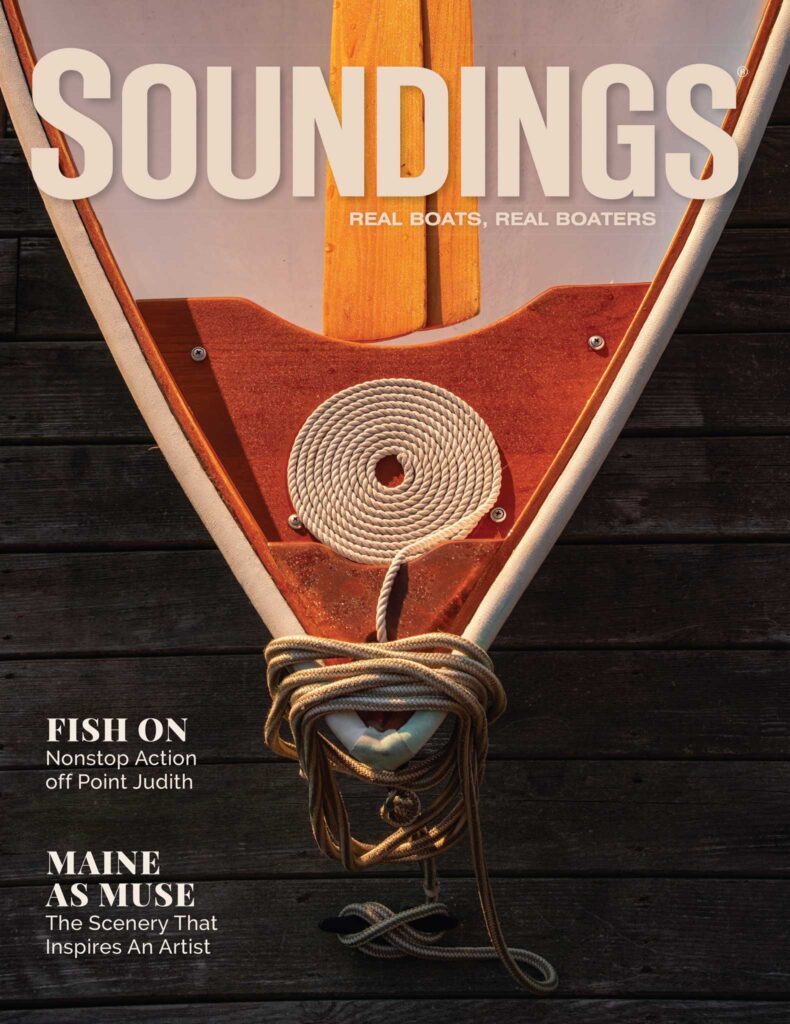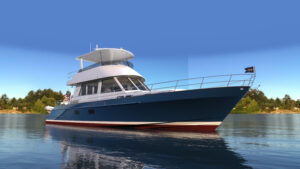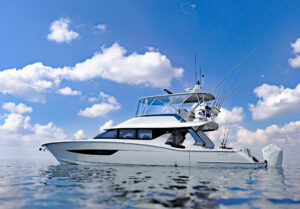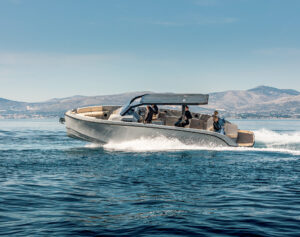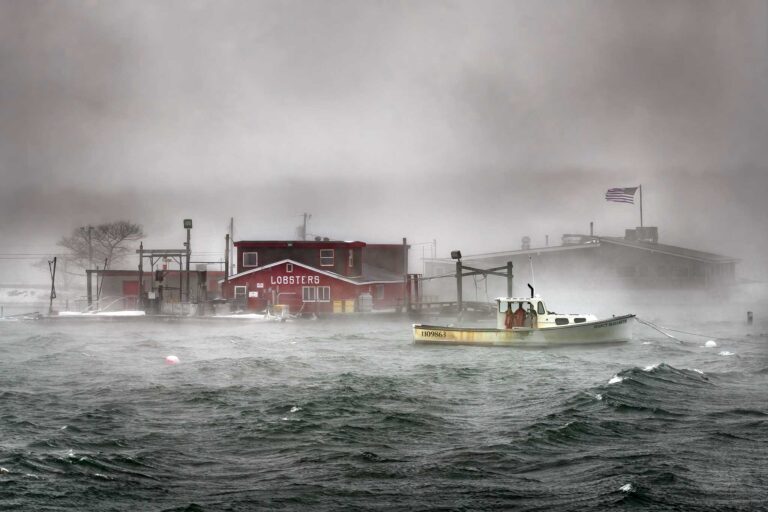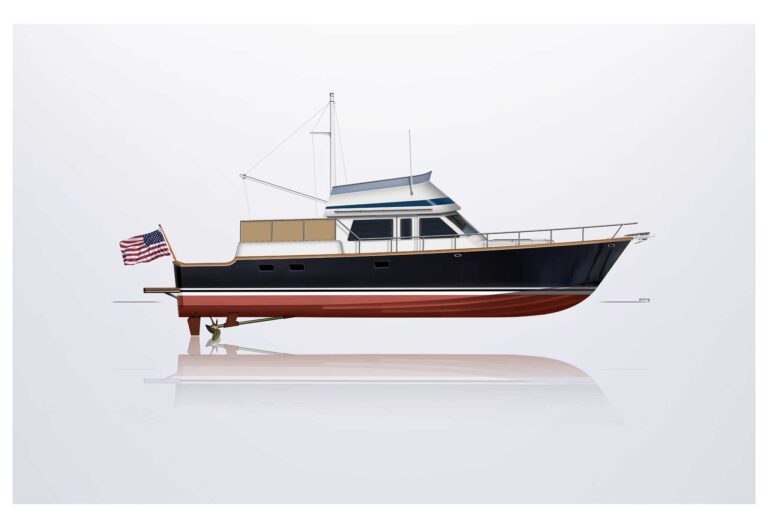If you’ve been thinking about a traditional-looking, economical boat from 18 to 35 feet and appreciate a little intelligent engineering and 21st century construction, read on about Eastern and Seaway boats, based in Milton, N.H. The company — Seaway is part of Eastern and is a February 2010 acquisition — had a few pleasant surprises to offer when I visited its facility this summer.

First, a little background. Eastern (www.easternboats.com) began building an 18-footer in 1981, an open, outboard-powered workboat originally known as a Norton. Old boats finding new identities is not uncommon. With builders going in and out of business through the years, it’s been relatively easy for entrepreneurs to set up shop after picking up a set of molds at auction. In any event, the Eastern 22 was added to the line a few years later, followed by a variety of models that the company started building under contract and then outright.
Bob Bourdeau went to work for Eastern’s owner in 1989, managing the Eastern Marine sales and service center in East Rochester, N.H. Running that operation, Bourdeau came to appreciate the potential of the boatbuilding business. He also came to understand the profit potential for a company with low overhead building a simple boat in reasonable volume. “It comes in a drum and sells at retail at a boat show,” Bourdeau says.
In 1993, Bourdeau bought the business and set about increasing the marketing budget, expanding the line and enlarging the plant to keep up with demand. The builder took a big leap in 1994 when it acquired the JC 31 and JC 35 tooling (workboats seen all over the New England waterfront), which became the Eastern 31 and 35. Eastern kept increasing its manufacturing capacity and today it owns a 30,000-square-foot plant in Milton.
Milton is 25 miles from the nearest salt water in Portsmouth, N.H., but the location — without the high costs that go along with waterfront property — works well for the builder. Bourdeau’s house is on the water and his dock conveniently serves as the company’s test center.
Eastern and Seaway originally sold boats factory-direct, but in 2006 they started setting up their own dealer networks to cast a wider sales net. Now there are dealers from Maine to Florida, selling boats across the country.
Seaway Boats, whose line overlaps from 18 to 24 feet with Eastern, was started in Maine in the 1970s (www.seawayboats.com). When Seaway came upon hard times during the recession that started in 2008, Bourdeau bought his biggest competitor. The brands may overlap, but the Seaways are more upscale. They have fancier woodwork; upgraded components, such as teak windshields and handrails; nicer running lights; pop-up (vs. fixed) cleats; full cabin liners, which make the boat more attractive and easier to clean inside; and more customization available. They also typically cost 10 to 12 percent more than their Eastern counterparts, which are more basic boats with commercial outfitting and finish.
Seaway and Eastern are sold through separate dealer networks because Bourdeau wants the dealers to feel loyal to their brands and to focus on selling clearly differentiated products to their customers. It’s also part of a growth strategy. “We started as a niche, regional builder, but now we are developing a presence across the country,” Bourdeau says. “A lot of people are looking for the Maine look, along with functionality, simplicity and value, and that’s what we are offering. Now we’re more of a national brand, shipping boats to Texas, Michigan, Washington, you name it. We’ve also hired a marketing company to help us grow the brand.”
Ups and downs
The company had to work hard to stay profitable through the economic downturn and has not come out of it unscathed. The builder had 40 employees in 2007, let half of them go in 2008, and is now up to 30 employees. The company built 117 boats in 2007, its best year, dropped to 54 boats in 2008, which was the nadir, and is on track to build 108 boats this year, although the average boat is smaller than it was a few years ago. Eastern sold a lot of 31s and 35s in 2007, and none so far this year.
“Part of the problem for us is that dealer floorplanning [wholesale financing for dealers’ boats in inventory] is more expensive, so dealers are not stocking big boats like they used to,” Bourdeau says. “The big-boat market took a real hit, though we are now getting more inquiries for our larger models and expect to start building them again this winter. Still, compared to many other boatbuilders and many other businesses, we’ve been very fortunate.”
“We sell a lot of boats because they look like Maine lobster boats, but our boats are also built strong and light, so they perform well with low horsepower,” says Bruce Perkins, Eastern and Seaway’s director of sales and marketing. “You won’t find a lot of upholstery or wood in our boats, so they are easy to own, and they also hold their value.”
For Eastern’s 30th anniversary this year, the company held a promotion with the 18-foot Eastern center console. “We simplified it with no liner and a 50-hp Mercury, priced it at $19,995 and sold 23 of them as soon as we announced it,” says Perkins. “For the Seaway brand, we offered a similar promotion: $42,995 for a 24 Seaway with a 115-hp Mercury, no cabin liner, a fiberglass V-berth and a poly 64-gallon fuel tank. We’re returning to a simpler time with a very basic 24-footer and, based on sales so far, we’re very glad we did.“
A quick note: I’ll say for the record that the 24 Seaway is a very nice boat that does everything the builder says it will, but the 115-hp Mercury 4-stroke on our test boat was noticeably loud (unlike the Verado 4-strokes). Be sure to try the boat to see whether it’s an issue for you, but I’d pay the up-charge for the Yamaha 4-stroke, Mercury Verado or the Evinrude.
Times are still tough for many boatbuilders, so Bourdeau is also updating the product line to give the dealers something new to show customers. (The company also sells to commercial users, such as fire departments and local police.) For example, although none of the Easterns had inner cockpit and cabin liners (the fiberglass part on the inside of the boat that covers the hull sides and creates the deck and cabin) four years ago, most of them now do. “We’re trying to be creative, giving dealers the right mix to be successful in this economy,” Bourdeau says. “Our boats are not expensive, but we use quality components, like Diamond Sea Glaze windows and all-composite fiberglass parts. Our boats are simple to maintain and less expensive to buy than many other brands, and they’re also less expensive to own. For example, our 24 goes 30 mph with a 115 Mercury, so it will cruise easily at 20 or 22 mph, which is plenty for most people.”
Casting a wider net to entice the cruising set, Eastern is coming out with a $90,000 Yamaha F150-powered Islander 248 cruiser, a fine boat you can actually beach with impunity and picnic in. The boat has a one-piece fiberglass unit that creates an angled, aft-facing seat to port, with a sink and refrigerator. The transom seat is molded as part of the cockpit liner, so the boat only comes with bracket-outboard power, but that has the advantage of getting the engine noise and fumes (such as they are) out of the cockpit. The cruiser focus also shows in the narrower coamings/washboards opening up cockpit width and a full-length hardtop (introduced at the Annapolis Powerboat Show) that covers most of the cockpit. Ordinarily I would be wary of so much hardtop up high on a small boat. The center of gravity moves toward a weight addition — in this case, it rises with the added weight up high, decreasing stability. But as long as the builder keeps it light with Nida-Core coring, it should be an acceptable feature.
Also, a word about the Eastern 248’s performance, because most people love a boat that’s miserly at the gas dock. The builder’s figures, with the Yamaha F150 and a light load and clean bottom, show a 32-knot top end at 5,500 rpm and a 27-knot cruise at 4,500 rpm. (Our test boat’s prop was on the large end of the scale, with the engine turning only 5,500.) Based on these numbers, even with the boat loaded you should expect a 23- or 24-knot cruise. The economy is remarkable for a 24-footer: 3,000 rpm produces 14.5 knots at 4.2 nmpg, and at 4,000 rpm you get 22.5 knots at 3.65 nmpg. At the risk of repeating myself, look what happens when you slow down and keep her light. The 248 is being rolled out as the company’s showpiece at the fall boat shows.
Eastern and Seaway customers typically have owned several boats and have a good idea what they don’t want: the complexity and expense of today’s express cruisers and other overloaded designs. “Our customer historically has been a little older, from 40 to 70, and has been boating their whole life,” Bourdeau says. “We sell to a lot of ex-sailors when the rigging gets to be too much to handle, and one of our lobster boat designs lets them save face down at the yacht club. Then the striper fishing craze started, and people wanted to go offshore to fish without breaking the bank or their backs in rough water. Most of our boats cruise at 20 knots the way they’re set up and that does the trick. At the end of the day you just hose them off and go home.”

Construction
The most impressive thing about the Eastern and Seaway operation was seeing how the boats are built. All of the boats start with 3 ounces of mat wet out in vinylester resin (not just sprayed on) over the gelcoat to help prevent osmotic blistering and improve the cosmetic finish by reducing print-through. All of the hulls are supported by female-molded fiberglass grids, which produce a consistent hull support structure and foundation for the deck and fuel tanks while providing a tooled bilge back aft. The grids are also designed to double as rigging tubes, which allow wires and hoses to be routed, say, from the center console back to the engine at the transom. Once they are bonded in place, the grids are filled with foam to add flotation, stiffen the grid structure and quiet the ride.
I also like the way these grids are designed. They flare out quite a bit from the top down, which means that each grid stringer is much wider at the base, and the stringer flanges farther apart, so the hull bottom panels, in turn, are smaller overall than they otherwise would be. It makes for a very efficient structure and, if it’s done right, it allows the builder to take a little more weight out of the boat without compromising strength and stiffness.
The trailerable boats have solid fiberglass hulls with Coremat in the sides to add bulk and stiffness at less weight, a cost-and-complexity compromise between building up a thick and heavy fiberglass laminate and using coring. The Eastern 31 and 35 hulls, decks and bulkheads are cored with Nida-Core, a high-end plastic honeycomb structural core that also does a great job of reducing noise in the hull bottom and sides. Two layers of 1808 (a non-woven fiberglass reinforcement) go on inside and outside of the core. The hull is solid glass at the sheer, chines and keel to accept fasteners and resist compression. All of the boats get Nida-Core cored bulkheads and decks, and it’s this use of relatively high-tech materials that makes the boats so much lighter than they would be with solid fiberglass or plywood cored structures.

Hull design
Depending on your frame of reference, these are either wonderfully efficient 16- to 20-knot boats or hard-riding and efficient 30-knot boats. Your frame of reference depends on what you’re used to, of course, but you should consider any product on its own merits. Let’s consider what these boats are not: overloaded floating doublewides; overly complex, styling-driven, 30-knot crab smashers; or mini floating gin palaces. They are graceful, sensibly proportioned, sparsely outfitted, reliable, easy-to-own, moderate-weight sea boats.
If you want to go 30 knots in 2- to 3-footers and keep up with a Grady-White, you should buy the Grady-White or one of the brands that can keep up with one offshore. These Maine-style boats are just too shallow forward and too flat aft to do 30 knots comfortably in anything more than a 1-foot chop. However, if you’re coming out of a sailboat, you’ll likely swoon at the thought of going 18 knots directly into the chop. If you owned a trawler, you’ll thrill at being able to get up on plane without needing a fire hose for a fuel supply line. If you just sold your express cruiser, you’ll kiss the mechanic you won’t have to call every time you get back to the dock to fix the icemaker, patch the chipped granite countertop, change the generator oil, service the clothes dryer, etc.
What these boats offer is a very comfortable and easily propelled hull form that comes into its own at 8 to 20 knots. They slide right up on plane with little resistance at hump speed, and that’s because they are so light for their size, which minimizes bottom loading. And despite being outboard-powered, the center of gravity is comfortably forward for the simple reason that a 115-hp Mercury 4-stroke (as on our Seaway 24 test boat) weighs 399 pounds, which is 263 pounds less than a 250-hp Mercury Verado 4-stroke, a common power plant on a 24-foot deep-vee. That’s like taking my sister’s friend Hilda off the swim platform and leaving her on the dock. A lighter stern, as well as a lighter boat, makes it easier to climb on plane, so you can run along at 9, 10 or 11 knots without dragging half of the bay with you.
One unique hull feature is the hard chines aft and round bilges forward on many Eastern and Seaway models. The lack of a chine forward probably makes the boat a little wetter, and dynamic lift down sea may take a hit. However, the chines aft are the way to go on any boat that spends much time over 16 to 20 knots because those hard corners create water-flow separation away from the hull, which reduces drag and increases speed. They also add lift because they create more effective bottom area, and they add a little form stability so the boat doesn’t rock and roll quite as deeply. The hard chines also are appropriate because these boats have a moderate beam for their length, which makes the ride better and reduces the power it takes to push them through the water.
Conclusion
I’ve been encouraging a simpler-is-better approach for a while now, and the Eastern and Seaway brands make my case nicely. You can buy one of the trailerable models for much less than you’d pay for a production boat with three times the power and four times the stuff. You can have the builder add custom touches so you feel as if you have something of yourself in it, and you’ll pat yourself on the back when you pull up to the gas dock and put 30 gallons into the tank instead of 130. You can be happy without the iPod, the 400-watt speakers, the half-acre of sunpads, the refrigerator and icemaker every 10 feet, the bloated proportions, the fake-teak swim platform, and the radar arch you can’t see around.
On one of these boats you can overnight, easily beach it for a picnic (unlike other so-called “picnic” boats), catch a few stripers, haul a few traps or take a sunset cruise. They’re good sea boats if you don’t push them too hard when the wind blows or load them up with too much stuff. With the modest sail area, you won’t get blown around the marina like an inflatable tow toy. These boats stand on their own merit, they’re easy to buy and easy to live with, and you’ll have every bit as much fun. Simplicity is its own reward whenever you want it to be.

Eric Sorensen is a consultant to boat- and shipbuilders and to the government. He was founding director of the J.D. Power and Associates marine practice and is the author of “Sorensen’s Guide to Powerboats: How to Evaluate Design, Construction and Performance.” A longtime licensed captain, he can be reached at [email protected].
This article originally appeared in the November 2011 issue.

